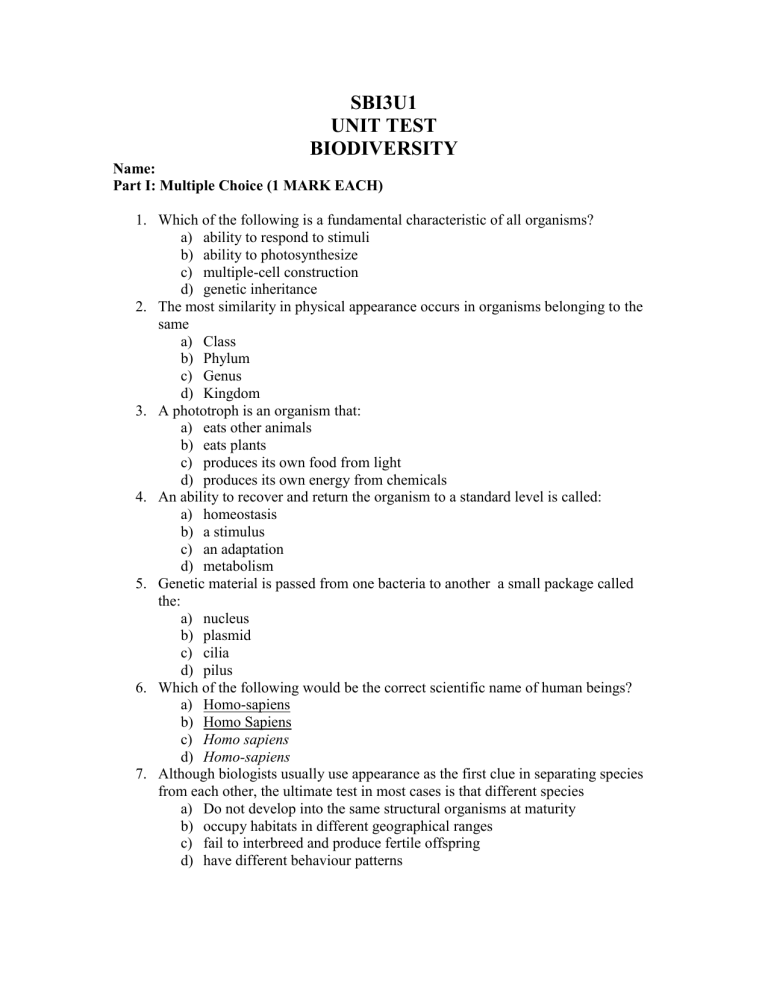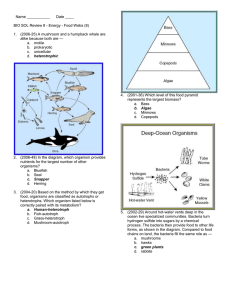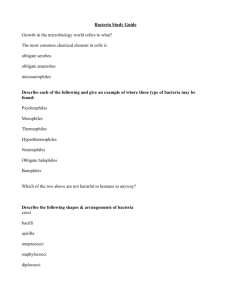sbi3u1-diversity unittest-05
advertisement

SBI3U1 UNIT TEST BIODIVERSITY Name: Part I: Multiple Choice (1 MARK EACH) 1. Which of the following is a fundamental characteristic of all organisms? a) ability to respond to stimuli b) ability to photosynthesize c) multiple-cell construction d) genetic inheritance 2. The most similarity in physical appearance occurs in organisms belonging to the same a) Class b) Phylum c) Genus d) Kingdom 3. A phototroph is an organism that: a) eats other animals b) eats plants c) produces its own food from light d) produces its own energy from chemicals 4. An ability to recover and return the organism to a standard level is called: a) homeostasis b) a stimulus c) an adaptation d) metabolism 5. Genetic material is passed from one bacteria to another a small package called the: a) nucleus b) plasmid c) cilia d) pilus 6. Which of the following would be the correct scientific name of human beings? a) Homo-sapiens b) Homo Sapiens c) Homo sapiens d) Homo-sapiens 7. Although biologists usually use appearance as the first clue in separating species from each other, the ultimate test in most cases is that different species a) Do not develop into the same structural organisms at maturity b) occupy habitats in different geographical ranges c) fail to interbreed and produce fertile offspring d) have different behaviour patterns 8. Viruses infect all of the following organisms, except: a) porifera b) fungi c) prions d) archeabacteria 9. The primary reason for the ability of the common cold to keep infecting us is its a) strong Gram positive wall b) high mutation rate c) high reproduction rate d) ability to complete conjugation 10. Viruses that reproduce by inserting their DNA into the host cell DNA by recombination are called a) anaerobic b) lysogenic c) lytic d) antibiotic 11. The relationship between a virus and its host is called a) commensalism b) advantagism c) lytic d) parasitism 12. If you looked at a Slinky ® walking down the stairs, it kind of resembles the bacteria… a) staphlyobaccilli b) streptococci c) monospirilli d) streptovibria 13. If an organism is prokaryotic, unicellular, and heterotrophic it is likely a… a) fungus b) plant c) bacteria d) protist 14. If an organism is eukaryotic, multi-cellular, and heterotrophic it is likely a… a) bacteria b) plant c) fungus d) protist 15. If a bacteria goes through 4 consecutive cycles of binary fission, the total number of cells will be… a) 32 b) 8 c) 6 d) 16 16. Fungus reproduce by…. a) binary fission b) sexual reproduction c) asexual reproduction d) two of the above are true 17. The Kingdom Protista contains a) mushrooms and molds b) eubacteria and archaebacteria c) amoebas and algae d) mosses and lichens 18. A bacteria that must live in the presence of oxygen is called a(n) a) facultative aerobe b) obligate anaerobe c) facultative anaerobe d) obligate aerobe 19. In the taxonomic hierarchy, Families are grouped into a larger category called a) Class b) Order c) Kingdom d) Phylum 20. The HIV virus attacks a) the whole body b) skin cells c) blood cells d) brain cells 21. Which is the oldest Kingdom? a) Eubacteria b) Plantae c) Archaebacteria d) Protista 22. What is the size of most bacteria? a) 0.01 to 0.1m b) 0.1 to 1m c) 1 to 10 nm d) 10 to 100m 23. Which of the following distinguishes mammals from birds? a) live birth of offspring b) warm blooded c) ability to fly d) closed circulatory system 24. How many Orders are there in the Phylum Chordata? a) 4 b) 5 c) 6 d) 7 Use the following graphs to answer questions 25 to 28 25. What species of bacteria above is a CHEMOTROPHIC OBLIGATE ANAEROBE? a) 1 b) 2 c) 3 d) 4 26. What species of bacteria above is an OBLIGATE AEROBE? a) 1 b) 2 c) 3 d) 4 27. What species of bacteria above is a CHEMOTROPHIC FACULTATIVE AEROBE? a) 1 b) 2 c) 3 d) 4 28. What species of bacteria above is a PHOTOTROPH? a) 1 b) 2 c) 3 d) 4 29. While sharing some Tic-Tacs ® with a friend in the car, you accidentally spill a bunch on the seat that form a big cluster in the spot between you. Being a keen biology student, you think to yourself that these most closely resemble the bacteria…. a) staphlyobaccilli b) streptococci c) monospirilli d) streptospirilli 30. A bacteriophage that invades a bacterium and immediately attacks the DNA of the cell is called a) an archaebacteriophage b) a lytic bacteriophage c) a lysogenic bacteriophage d) a commensalistic bacteriophage 31. A purple colony of bacteria when Gram Staining assures that a) the bacteria move via cilia b) the bacteria seep endotoxins c) the bacteria have thick cell walls d) the bacteria have thin cell walls 32. Who should you definitely NOT invite over for dinner? a) Lindsay Lohan (She won’t eat anything) b) King Phillip c) Mr. Ruf d) Long winded Auntie Flo. Part II : Mix ‘N’ Match (1 MARK EACH) During our unit, we encountered several organisms from many different phyla and classes. Match the names of the phyla/class with the examples of organisms provided. The scientific name or the common name of the organism may be listed. **PLACE THE CORRECT LETTER OF THE EXAMPLE BESIDE ITS** **PHYLUM/CLASS ON THE LEFT** Phylum/Class Example Organisms 33. Echinodermata ( ) A. Octopus vulgaris 34. Insecta ( ) B. Stove pipe sponge 35. Porifera ( ) C. Haliaeetus leucocephalus 36. Mammalia ( ) D. Slate-pencil urchin 37. Mollusca ( ) E. Gersemia rubiformis 38. Bronchioplantes ( ) F. Class: Oligochaeta 39. Platyhelminthes ( ) G. Mexican axolotl 40. Arachnida ( ) H. Carcharodon carcharias 41. Aves ( ) I. Dermochelys coriacea 42. Amphibian ( ) J. Tapeworm 43. Chondrichthyes ( ) K. Musca domestica 44. Crustacea ( ) L. Cheetah 45. Cnidaria ( ) M. You made that up Mr. Shanks! 46. Annelida ( ) N. Dermatophagoides pteronyssinus 47. Reptilia ( ) O. Japanese spider crab During our study we took a closer look at animals that possess a spinal cord. Match the characteristics listed with Mammals, Birds, Reptiles, Amphibians, or Fish with the letters M, B, R, A, or F, respectively. Each letter is used TWICE 48. ________ Spends early part of life in water 49. Eggs are fertilized externally 50. Bones are hollow 51. Have specialized teeth for a greater range in diet 52. Some have bony plates that form a shell 53. The only Order that has feathers 54. Body is covered in hair 55. Some swim, most walk 56. Move by swimming, walking or hopping at different stages 57. Have cartilaginous skeletons PART III: SHORT ANSWER (1 MARK EACH) 58. The largest diversity of animals can be found in the class ________________ 59. The two ways that a bacteria can react to poor conditions are…. _______________________________ and ___________________________ 60. Of the other five Kingdoms, Animals are most closely related to________________ 61. For an organism to be ‘alive’ it must be able to change from an earlier form to a mature different form. This is referred to as… _____________________ 62. The maintenance of a stable internal environment is a fundamental characteristic of living things. This is called ______________________________ 63. Cellulose will be found on the outer covering of cells in the Kingdom _________________ . 64. An example of a lytic DNA virus is ____________________________. 65. Endotoxins may be released by GRAM ___________________ bacteria. 66. 3 structures you would find inside a bacterial cell are…. 67. Draw a Bacteriophage (1 Mark) Note: ‘Cool’ cartoon versions are especially appreciated. Part IV: RESPONSE (MARKS INDICATED) **ANSWER THESE QUESTIONS ON THE LINED PAPER PROVIDED** 68. As a well recognized microbiologist, you have been invited to speak at a conference about the value of creating a 7th Kingdom: Virusea. Decide if you believe that viruses should be considered ‘Alive’ or not, and make point form notes defending your side in the argument. (6 MARKS) 69. It seems that in a general sense, the people of wealthy nations stay healthy while the people of poor nations are more terribly affected by sicknesses. Corporations have made large profits treating these illnesses, but have opted not to help struggling nations at a cost they can afford in lieu of the profit margin and maintaining reputable business partners in North America. Decide if you think drug companies should be morally obligated to help poorer nations with their treatment or should be treated the same as all other business organizations and should not be financially punished for running a successful business. Write a short response arguing one way or the other. (6 MARKS) TOTAL Part I: Multiple Choice 1. 9. 2. 10. 3. 11. 4. 12. 5. 13. 6. 14. 7. 15. 8. 16. /82 17. 18. 19. 20. 21. 22. 23. 24. 25. 26. 27. 28. 29. 30. 31. 32.



